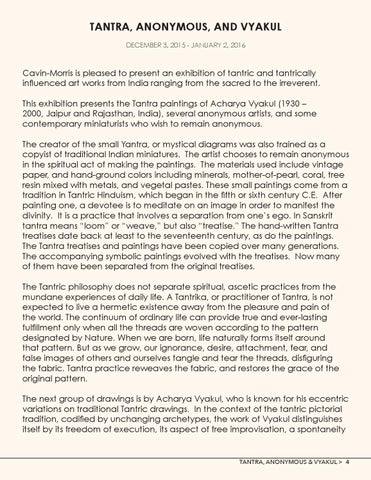TANTRA, ANONYMOUS, AND VYAKUL DECEMBER 3, 2015 - JANUARY 2, 2016
Cavin-Morris is pleased to present an exhibition of tantric and tantrically influenced art works from India ranging from the sacred to the irreverent. This exhibition presents the Tantra paintings of Acharya Vyakul (1930 – 2000, Jaipur and Rajasthan, India), several anonymous artists, and some contemporary miniaturists who wish to remain anonymous. The creator of the small Yantra, or mystical diagrams was also trained as a copyist of traditional Indian miniatures. The artist chooses to remain anonymous in the spiritual act of making the paintings. The materials used include vintage paper, and hand-ground colors including minerals, mother-of-pearl, coral, tree resin mixed with metals, and vegetal pastes. These small paintings come from a tradition in Tantric Hinduism, which began in the fifth or sixth century C.E. After painting one, a devotee is to meditate on an image in order to manifest the divinity. It is a practice that involves a separation from one’s ego. In Sanskrit tantra means “loom” or “weave,” but also “treatise.” The hand-written Tantra treatises date back at least to the seventeenth century, as do the paintings. The Tantra treatises and paintings have been copied over many generations. The accompanying symbolic paintings evolved with the treatises. Now many of them have been separated from the original treatises. The Tantric philosophy does not separate spiritual, ascetic practices from the mundane experiences of daily life. A Tantrika, or practitioner of Tantra, is not expected to live a hermetic existence away from the pleasure and pain of the world. The continuum of ordinary life can provide true and ever-lasting fulfillment only when all the threads are woven according to the pattern designated by Nature. When we are born, life naturally forms itself around that pattern. But as we grow, our ignorance, desire, attachment, fear, and false images of others and ourselves tangle and tear the threads, disfiguring the fabric. Tantra practice reweaves the fabric, and restores the grace of the original pattern. The next group of drawings is by Acharya Vyakul, who is known for his eccentric variations on traditional Tantric drawings. In the context of the tantric pictorial Untitled, 1993 tradition, codified Mineral pigment on paperby unchanging archetypes, the work of Vyakul distinguishes itself xby 21.25 23its in/freedom 54 x 58.5 cmof execution, its aspect of free improvisation, a spontaneity Nel TANTRA,ANONYMOUS ANONYMOUS&&VYAKUL VYAKUL > TANTRA, > 4 4
